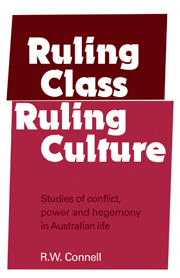Book contents
- Frontmatter
- Contents
- Table and Figures
- Preface
- Acknowledgements
- 1 Approach to class analysis
- 2 The idea of class in Australian social science
- THE RULING CLASS
- 3 The structure of the ruling class
- 4 The major companies
- 5 Conflict in the ruling class, 1970–1972
- 6 Ruling-class responses to Labor, 1973–1975
- THE RULING CULTURE
- Notes
- Index
3 - The structure of the ruling class
Published online by Cambridge University Press: 05 January 2012
- Frontmatter
- Contents
- Table and Figures
- Preface
- Acknowledgements
- 1 Approach to class analysis
- 2 The idea of class in Australian social science
- THE RULING CLASS
- 3 The structure of the ruling class
- 4 The major companies
- 5 Conflict in the ruling class, 1970–1972
- 6 Ruling-class responses to Labor, 1973–1975
- THE RULING CULTURE
- Notes
- Index
Summary
The idea of a ‘ruling class’ is itself a structural concept, embodying claims about the way relations extending through the whole society are ordered. It is a logical step from analysing the structure of relations between classes to analyse the structure of relations within them. If some of the same principles can be shown to apply, the original theorizing will be greatly strengthened. An account of the internal structure of classes is necessary if class analysis is to be properly historical, if the formation and conflict of classes is to be understood in anything but the most abstract way. Classes are never homogeneous, and the situation faced by any person or group within a class is in large part made up of relationships with others in the same class. An analysis of the structure of these relationships is required both to make the reasons for their actions intelligible, and to understand their consequences.
The basic hypothesis of socialist analyses of capitalism is that its ruling class is defined by the private ownership of productive resources, and this can be taken as the starting point for an analysis of ruling class structure. Private ownership of productive resources takes a number of forms. Some of them involve ownership on quite a modest scale, such as the family ownership of a farm – though it is typical of Australian rural life that ways have been found of coordinating the activities of these pocket-handkerchief units of ownership through fifty-seven varieties of boards, pools, cooperatives and authorities.
- Type
- Chapter
- Information
- Ruling Class, Ruling Culture , pp. 39 - 59Publisher: Cambridge University PressPrint publication year: 1977
- 1
- Cited by

